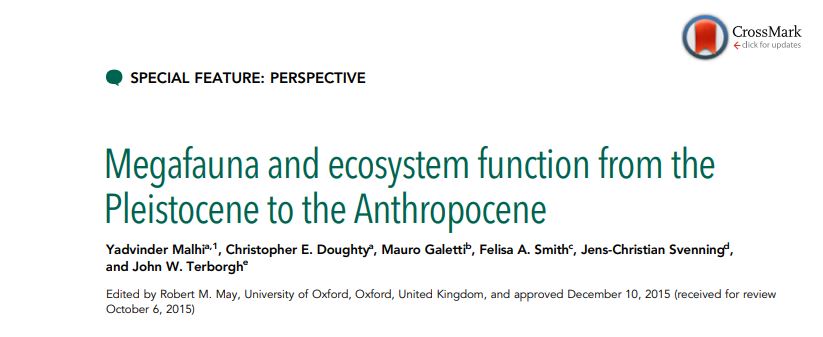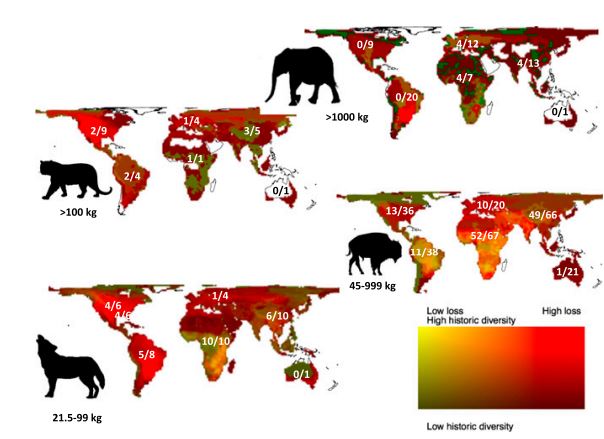1/ An exploration into the role of megafauna, ecosystem functioning and #rewilding is the topic of #rewildingscience today. Can we learn from the Pleistocene to influence today’s world for the better?
2/ As discussed in previous threads, megafauna have been in a state of decline and extinction since the late Pleistocene. Such large animals would surely have an impact on the environment so what are the consequences of their declines on ecosystem function?
3/ Understanding not only why they went extinct but how their loss effects ecosystem functioning is important for many reasons. Arguably the most pressing of which is how their legacy has an impact on the functioning of the current biosphere
4/ Firstly, what is meant by ‘megafauna’? In the context of the paper these are categorised into the following groups: large herbivores (45-999kg), megaherbivores (>1000kg), large carnivores (21.5-99kg), and megacarnivores (>100kg)
5/ The sheer size of these animals would not only have had a direct impact on vegetation, but also interactive effects e.g. landscape of fear. The drop from 50 megaherbivore species to our current 9 worldwide within a depleted range would surely have a trophic impact
6/ What then are the key impacts of their loss? These are split into sections, the first of which is ecosystem physical structure. Browsers, particularly elephants, shape the landscape through destruction of vegetation…
7/ In many ecosystems, these destructive drivers act alongside fire. Adding influences like rainfall and ecosystem productivity, varied environmental states are possible. By removing or adding browsers, shifts in state can occur e.g. a switch from top-down to bottom-up processes
8/ For example, after late Pleistocene megafaunal decline, it has been suggested that there was further inhibition of woody vegetation growth, due to the relationship between megafauna and vegetation (made worse by low CO2), making plants more susceptible to browsing pressure
9/ Spatial and temporal landscape structure can also be influenced by these animals. Strength of megafauna pressure can result in landscapes that are mosaics of grasses, shrubs, and trees due to varied strength in herbivory. This creates a more biodiverse landscape
10/ The afforementioned landscape of fear also plays a role, with Yellowstone being a key example. The reintroduction of wolves seems to have decreased browsing pressure by American elk, resulting in regrowth of willow tree cover and reduced erosion
11/ Loss of these species, therefore, can induce trophic cascades that lead to habitat change and further extinction such as the well-known removal of sea otters allowing sea urchin explosions in kelp forests
12/ The second effect concerns ecosystem biochemistry. Large animals play a disproportionately important role in accelerating biogeochemical cycling. Nutrients that would normally have been locked up for years in leaves and stems are processed through consumption and waste…
13/ Lateral movement of nutrients by larger animals can alter soil structure, soil methane emissions, and affect land albedo and evapotranspiration. This process, alongside browsing pressure can alter the reflective component of habitats, effectively influencing climate change
14/ The ecological role of megafauna is being increasingly discussed in a conservation context. As megafauna numbers continue to decline, it is therefore important to recognise their ecological role and how these losses can be avoided
15/ Beyond this, an opportunity exists to explore how to rebuild the ecosystem functions provided by large animals. Sometimes this can be spontaneous, like the return of brown bear and wolves to some landscapes. But this can also be active…
16/ This particular aspect of large animal reintroduction is highly debated, and it is crucial to discuss the where and when of megafaunal #rewilding in terms of appropriateness and practicality. As the discussion continues, we may see avenues for human-megafauna coexistence
17/ Why is this important? Direct human pressure on megafaunal population are coinciding, once again, with an episode of rapid climate change. Restoring these megafauna and linked trophic cascades may, in places, provide ecological resilience in the face of this climate shift
18/ The more we understand about the megafaunal past, how they are agents of contemporary ecosystem change, and their role in the future, the more likely it is we can provide a framework we can develop and test
19/ please read this paper in full, as I wasn’t able to cover everything within this thread! It is an important read so follow the link here and comment your thoughts below https://www.pnas.org/content/pnas/113/4/838.full.pdf">https://www.pnas.org/content/p...
@threadreaderapp unroll

 Read on Twitter
Read on Twitter



